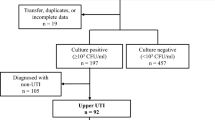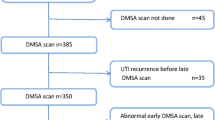Abstract
Introduction and hypothesis
The objective was to analyse the risk of significant bacteriuria in repeat urine cultures from pregnant women, following initial mixed bacterial results.
Methods
This retrospective study examined maternal characteristics and clinical features of women who repeated urine cultures due to previous mixed cultures results.
Results
Of 262 women included, 80 (30.5%) had negative cultures and 125 (47.7%) had mixed bacterial growth in their repeat cultures. Positive results (≥104 CFU/ml of a urinary pathogen) were obtained for 57 women (21.8% [95% CI 17.1–27.0]). For 37 (14.1%), the repeat specimen grew 104–105 CFU/ml of microorganisms; whereas for 20 women (7.6% [95% CI 4.9–11.3]), it grew ≥105 CFU/ml. Among women with positive (>104 CFU/ml) compared with those with negative or mixed growth, rates of urinary symptoms were higher (38.6% vs 23.4%, p=0.028), abnormal dipstick results (49.1% vs 21.0%, p<0.001) and hydronephrosis, as demonstrated by renal ultrasound (12.3% vs 2.0, p=0.003). In a multivariate logistic regression analysis, hydronephrosis was associated with the occurrence of a positive repeat culture (aOR = 10.65, 95% CI 2.07–54.90). The sensitivity and specificity for predicting a repeat urine culture with ≥105 CFU/ml were 12.9% and 94.3% respectively, for urinary symptoms; and 19.7% and 97.4% respectively, for abnormal dipstick results.
Conclusions
Mixed bacterial growth might represent a true urinary tract infection in a considerable proportion of women who are symptomatic and have an abnormal dipstick urinalysis.

Similar content being viewed by others
Data availability
Data are available from the corresponding author upon reasonable request.
References
Nicolle LE, Gupta K, Bradley SF, et al. Clinical practice guideline for the management of asymptomatic bacteriuria: 2019 Update by the Infectious Diseases Society of America. Clin Infect Dis. 2019;68(10):e83–e110. https://doi.org/10.1093/cid/ciy11212.
Kalinderi K, Delkos D, Kalinderis M, et al. Urinary tract infection during pregnancy: current concepts on a common multifaceted problem. J Obstet Gynaecol. 2018;38(4):448–53. https://doi.org/10.1080/01443615.2017.1370579.
Colgan R, Jaffe GA, Nicolle LE. Asymptomatic bacteriuria. Am Fam Physician. 2020;102(2):99–104.
Siegman-Igra Y. The significance of urine culture with mixed flora. Curr Opin Nephrol Hypertens. 1994;3(6):656–9. https://doi.org/10.1097/00041552-199411000-00017.
Folaranmi T, Harley C, Jolly J, et al. Clinical and microbiological investigation into mixed growth urine cultures. J Med Microbiol. 2022;71(5):1–5. https://doi.org/10.1099/jmm.0.001544.
Siegman-Igra Y, Kulka T, Schwartz D, et al. The significance of polymicrobial growth in urine: contamination or true infection. Scand J Infect Dis. 1993;25(1):85–91.
Bhugra A, Gachinmath S. Significant bacteriuria among requested repeat urine samples and its clinical correlation. Iran J Microbiol. 2021;13(5):592–601. https://doi.org/10.18502/ijm.v13i5.7421.
Colodner R, Eliasberg T, Chazan B, Raz R. Clinical significance of bacteriuria with low colony counts of Enterococcus species. Eur J Clin Microbiol Infect Dis. 2006;25(4):238–41. https://doi.org/10.1007/s10096-006-0132-0.
Hooton TM, Roberts PL, Cox ME, et al. Voided midstream urine culture and acute cystitis in premenopausal women. N Engl J Med. 2013;369(20):1883–91. https://doi.org/10.1056/NEJMoa1302186.
Payton S. Infection: utility of midstream urine cultures questioned. Nat Rev Urol. 2014;11(1):3. https://doi.org/10.1038/nrurol.2013.287.
Chu CM, Lowder JL. Diagnosis and treatment of urinary tract infections across age groups. Am J Obstet Gynecol. 2018;219(1):40–51. https://doi.org/10.1016/j.ajog.2017.12.231.
Giesen LG, Cousins G, Dimitrov BD, et al. Predicting acute uncomplicated urinary tract infection in women: a systematic review of the diagnostic accuracy of symptoms and signs. BMC Fam Pract. 2010;11:78. https://doi.org/10.1186/1471-2296-11-78.
Rogozińska E, Formina S, Zamora J, et al. Accuracy of onsite tests to detect asymptomatic bacteriuria in pregnancy: a systematic review and meta-analysis. Obstet Gynecol. 2016;128(3):495–503. https://doi.org/10.1097/AOG.0000000000001597.
Szkodziak P. Ultrasound screening for pyelectasis in pregnant women. Clinical necessity or "art for art's sake"? J Ultrason. 2018;18(73):152–7. https://doi.org/10.15557/JoU.2018.0022.
Naresh A, Simhan HN. Association of polymicrobial growth from urine culture with adverse pregnancy outcomes. Am J Perinatol. 2011;28(7):537–42. https://doi.org/10.1055/s-0031-1272972.
Funding
There was no funding obtained for this research.
Author information
Authors and Affiliations
Contributions
Inshirah Sgayer: project developmet, data analysis, manuscript writing; Gabriel Shamalov: data collection; Silas Assi: data collection; Daniel Glikman: infectious diseases consultation, manuscript editing; Lior Lowenstein: manuscript editing; Maya Frank Wolf: protocol/project development, manuscript editing.
Corresponding author
Ethics declarations
Conflicts of interest
None.
Additional information
Publisher’s Note
Springer Nature remains neutral with regard to jurisdictional claims in published maps and institutional affiliations.
Rights and permissions
Springer Nature or its licensor (e.g. a society or other partner) holds exclusive rights to this article under a publishing agreement with the author(s) or other rightsholder(s); author self-archiving of the accepted manuscript version of this article is solely governed by the terms of such publishing agreement and applicable law.
About this article
Cite this article
Sgayer, I., Shamalov, G., Assi, S. et al. Bacteriology and clinical outcomes of urine mixed bacterial growth in pregnancy. Int Urogynecol J 35, 347–353 (2024). https://doi.org/10.1007/s00192-023-05672-5
Received:
Accepted:
Published:
Issue Date:
DOI: https://doi.org/10.1007/s00192-023-05672-5




